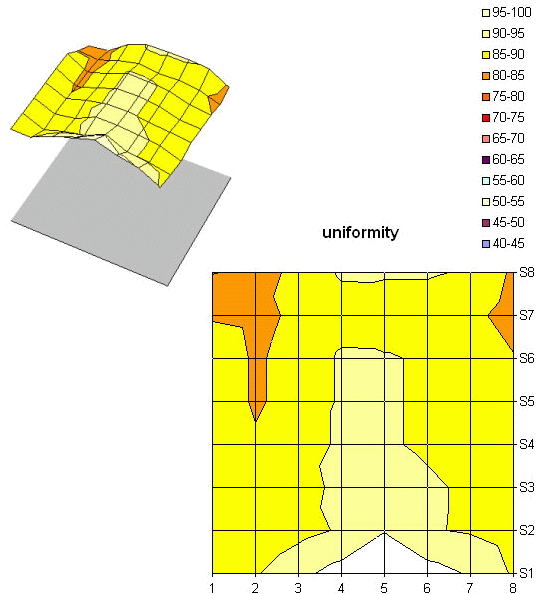Are 17" LCDs Dead?
Spatial Uniformity
A nice surprise, the panel is very uniform. All the values measured were squashed up within 15% of the total recorded brightness range, which is pretty good.

Up to this point, the T17-02 has shown mixed static performance. On the one side the uniformity of the panel is good, on the other color rendering is average. It remains to be seen if this monitor can be credited with better handling of moving images.
Fujitsu-Siemens Scaleoview T17-2: 8 Ms Just Like The Rest
Unsurprisingly, the T17-02 provides a classic latency for a 17" 8 ms TN panel. Without being exceptional, its performance would have been enough to haul itself to the top of the table a few months ago. But the VP191b has set the record straight. In the worst case the T17-2 hits a latency of 25 ms. That is pretty bad for a product sold as being capable of 8 ms -
but we know the reason for that.

In Practice
In an office environment, the T17-2 will behave honorably: the text is sharp but brightness is too garish. We advise you to limit the brightness to 50% when editing text documents even though you'll sacrifice a little color precision.
Stay on the Cutting Edge
Join the experts who read Tom's Hardware for the inside track on enthusiast PC tech news — and have for over 25 years. We'll send breaking news and in-depth reviews of CPUs, GPUs, AI, maker hardware and more straight to your inbox.
Video games seem to be the area where the T17-2 is most at home. With UT2004 or HL2, colors are nice and bright and one hardly notices image trails. We're still, however, below the VP191b . Latency is evident in the loss of clarity of moving textures.
Video, on the other hand, is disappointing. Video noise is too evident and viewing angles are too narrow. What's more, you need to reduce brightness, at the risk of seeing awful halos at the left of the panel. We're starting to despair that we'll never find a 17" LCD at the same level as that of the VP191b.
Conclusion
The T17-2 is aimed clearly as an entry-level product, and its performance is consistent with that. Sure, it's acceptable for video games and is a bit useful in the office, but that's where it stops. For not many more dollars, the ASUS PM17T-S offers much better performance.
Current page: Spatial Uniformity
Prev Page Fujitsu-Siemens Scaleoview T17-2: Low Profile Colors Next Page ViewSonic VP171sMost Popular

